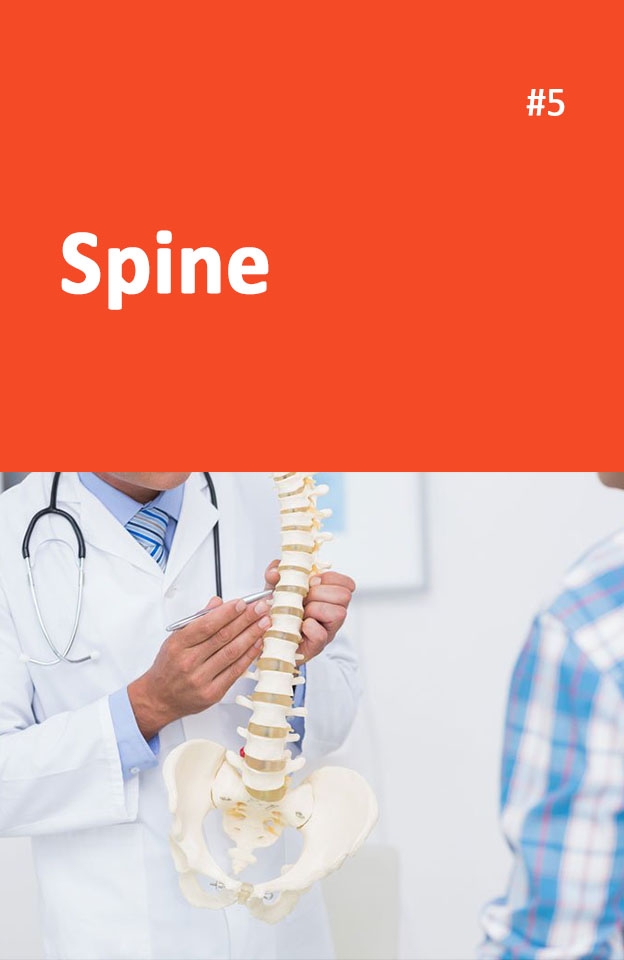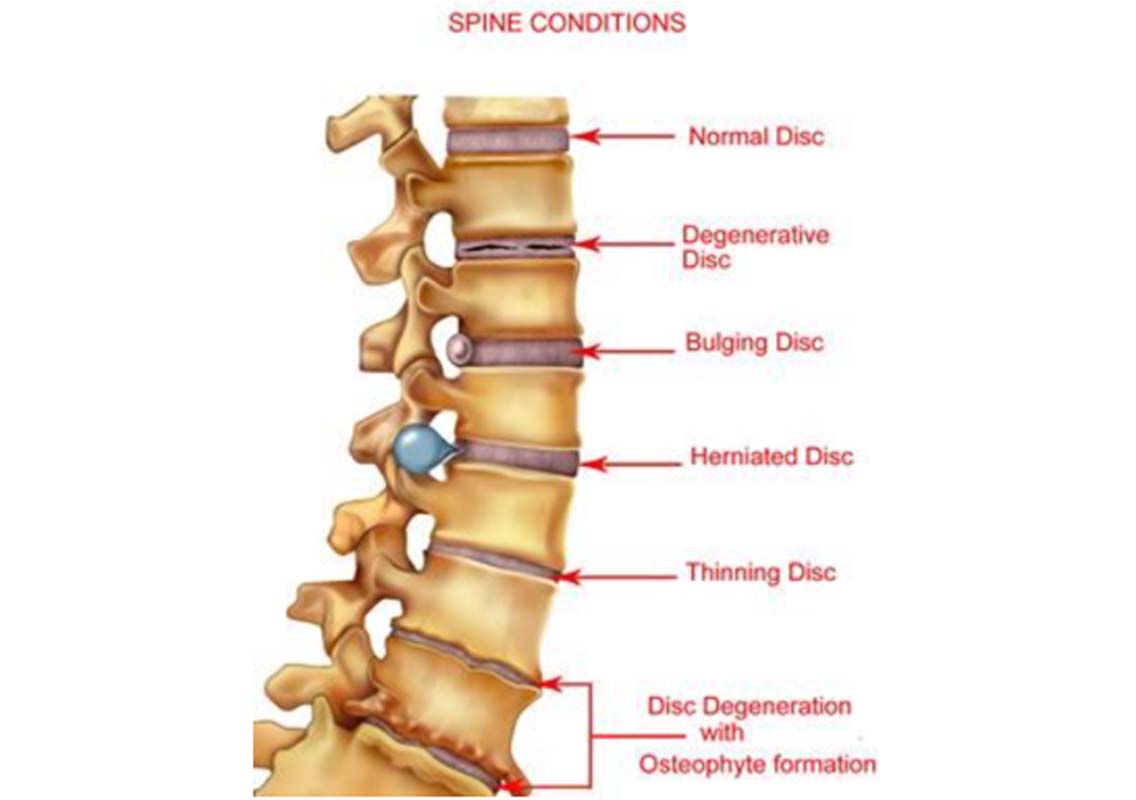Spine

Spine
Back pain is one of the most common reasons people go to the doctor or miss work, and it is a leading cause of disability worldwide. Most people have back pain at least once.Fortunately, you can take measures to prevent or relieve most back pain episodes. If prevention fails, simple home treatment and proper body mechanics often will heal your back within a few weeks and keep it functional. Surgery is rarely needed to treat back pain
Back pain often develops without a cause that your doctor can identify with a test or an imaging study. Conditions commonly linked to back pain include:
- Muscle or ligament strain: Repeated heavy lifting or a sudden awkward movement can strain back muscles and spinal ligaments. If you’re in poor physical condition, constant strain on your back can cause painful muscle spasms.
- Bulging or ruptured disc: Discs act as cushions between the bones (vertebrae) in your spine. The soft material inside a disk can bulge or rupture and press on a nerve. However, you can have a bulging or ruptured disk without back pain. Disk disease is often found incidentally when you have spine X-rays for some other reason.
- Arthritis: Osteoarthritis can affect the lower back. In some cases, arthritis in the spine can lead to a narrowing of the space around the spinal cord, a condition called spinal stenosis.
- Skeletal irregularities: A condition in which your spine curves to the side (scoliosis) also can lead to back pain, but generally not until middle age.
- Osteoporosis: Your spine’s vertebrae can develop compression fractures if your bones become porous and brittle
Who can developback pain?
These factors might put you at greater risk of developing back pain:
- Age: Back pain is more common as you get older, starting around age 30 or 40.
- Lack of exercise: Weak, unused muscles in your back and abdomen might lead to back pain.
- Excess weight: Excess body weight puts extra stress on your back.
- Diseases: Some types of arthritis and cancer can contribute to back pain.
When can surgery be considered?
Surgery may be considered if for severe lower back pain that does not get better after a 6 to12-week course of nonsurgical treatments and is associated with neurological symptoms It is almost always the patient’s decision to have back surgery, and only in rare situations is immediate surgery performed for low back pain.
What are common lower back surgeries ?
Most commonly performed surgeries for low back pain is intervertebral disc prolapse and canal stenosis
What is IVD?
Intervertebral disc disease is a common condition characterized by the breakdown (degeneration) of one or more of the discs that separate the bones of the spine (vertebrae), causing pain in the back or neck and frequently in the legs and arms. The intervertebral discs provide cushioning between vertebrae and absorb pressure put on the spine.
While the discs in the lower (lumbar) region of the spine are most often affected in intervertebral disc disease, any part of the spine can have disc degeneration. Depending on the location of the affected disc or discs, intervertebral disc disease can cause periodic or chronic pain in the back or neck. Pain is often worse when sitting, bending, twisting, or lifting objects.
Degenerated discs are prone to out-pouching (herniation); the protruding disc can press against one of the spinal nerves that run from the spinal cord to the rest of the body. This pressure causes pain, weakness, and numbness in the back and legs. Herniated discs often cause nerve pain called sciatica that travels along the sciatic nerve, which runs from the lower back down the length of each leg.
As a disc degenerates, small bony outgrowths (bone spurs) may form at the edges of the affected vertebrae. These bone spurs may pinch (compress) the spinal nerves, leading to weakness or numbness in the arms or legs. If the bone spurs compress the spinal cord, affected individuals can develop problems with walking and bladder and bowel control. Over time, a degenerating disc may break down completely and leave no space between vertebrae, which can result in impaired movement, pain, and nerve damage.

What are Spinal decompression surgeries?
Decompression is a common surgical procedure used to alleviate lower back pain caused by pinched nerves.
Some factors to consider before having back surgery include:
Ability to function: If it is possible to complete daily life activities with manageable pain levels, and if pain does not interrupt sleep or activity, nonsurgical treatments are usually recommended. Surgery is more likely to be recommended if the patient has limited ability to function in everyday life.
Healing process and lifestyle: Surgery vs. nonsurgical care require varying degrees of time commitment. It is important to consider how the healing process after surgery will affect the patient, as compared to continued non-surgical care.
Decompression Surgeries
Spinal decompression surgery is performed to relieve lower back pain or other symptoms caused by compression of the spinal cord or the spinal nerves.
Symptoms of spinal nerve compression
- Pain – especially in the lower back (lumbar spine) – but also possibly in the neck (cervical spine) or upper back (thoracic spine)
- Neuropathies (such as numbness or the “pins and needles” sensation of tingling)
- Feeling of weakness or instability in the back
In certain nerve compression conditions, such as spinal stenosis, you may also experience:
- Neuropathies in the arms, hands, legs or feet
- Balance problems
- Incontinence issues (bowel dysfunction, unexpected need to urinate, etc.)
What are the different Kinds of spinal decompression surgeries?
Laminectomy: Removal in one or more vertebrae of the lamina (bony roof over the spinal canal). This decompresses both sides (left and right) of the canal.
Laminotomy: Removal of a small portion of the lamina to decompress one side (left or right) of the canal. This leaves most of the lamina intact. Microsurgical laminoplasty: a minimally invasive surgical decompression technique that uses small incisions viewed through an operating microscope.
Microdiscectomy: A decompression surgery removes whatever is pressing on a nerve root from the spinal column, which might include a herniated portion of a disc or a bone spur. There are two primary types of decompression for low back pain. Microdiscectomy is a minimally invasive procedure for patients with a lumbar herniated disc causing radicular leg pain.
Advice for Recovering from Back Surgery
Some surgeries are considerably more invasive than others, and include lengthier healing periods, and varying inpatient hospital stays. With modern surgical approaches and an experienced surgeon, many types of spine surgery can now be done on an outpatient basis with a shorter recovery period where the patient is made to walk very next day.
